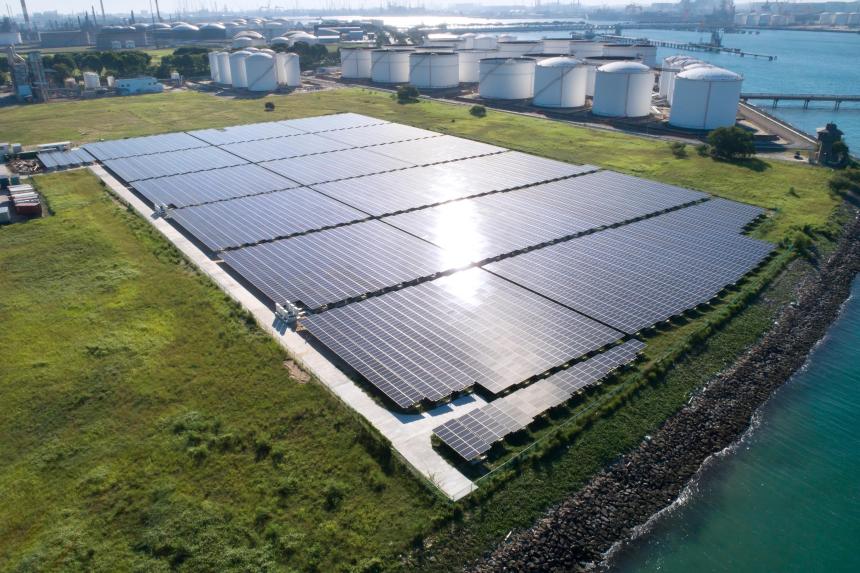SINGAPORE - JTC will increase the potential for Jurong Island to harvest energy from the sun eightfold, with the launch of a tender to install solar panels on 60ha of temporary vacant land and more rooftops at the oil hub.
These plans will boost total solar energy capacity on Jurong Island from 12.3 megawatt-peak (MWp) to 103.2 MWp, or the equivalent of powering 24,300 four-room Housing Board flats annually, JTC said in a statement on Wednesday.
Under the tender, solar panels will be installed on interim vacant industrial land – the size of about 84 football fields – and the rooftops of five buildings on Jurong Island, including Jurong Island Checkpoint, as well as land in Jurong Rock Caverns.
They will also cover 9,760 sq m of dead sea space – water bodies located within the companies’ waterfront that are not in use – in front of Jurong Rock Caverns, JTC said.
The system, which is expected to be ready in the second half of 2024, will export most of its electricity to the national grid, added JTC.
This comes as part of efforts to transform Jurong Island into a sustainable energy and chemicals park, and reduce its carbon footprint.
When completed, solar panels on Jurong Island will cover about 5 per cent of Singapore’s solar target for 2030, by which time the Republic aims to have installed solar capacity of 2 gigawatt-peak, a key pillar for the nation’s transition away from global-warming fossil fuels.
Solar energy has been marked as the most viable renewable energy resource for Singapore, which has low wind speeds and large ports that limit the potential to harness tidal energy.
To overcome Singapore’s limited land for large solar farms, JTC has been working to install panels in estates with more than 14,000 businesses through its SolarRoof and SolarLand programmes, to tap rooftops and temporary vacant industrial land space for solar power generation.
JTC chief sustainability officer Tan Chee Kiat said: “With this new initiative, Jurong Island will be one of Singapore’s largest solar-generating estates.”
The tender, which was called in December 2022, will feature next-generation mobile photovoltaic panels that can be redeployed as and when the plots of land are needed for industrial use.
The tender will also support the solar demand of 12 Jurong Island companies, which can work with the vendor to solarise their roofs and open carpark spaces at discounted rates and, if feasible, with zero upfront capital outlay.
JTC said: “They can do so by either leasing solar panels in return for the discounted electricity, or leasing roof or open carpark space to solar vendors to generate revenue. With economies of scale by aggregating the island’s solar demand, Jurong Island companies will be able to enjoy more competitive rates.”
Among the companies is ExxonMobil, which has ventured into making building blocks for materials used in solar panels.
Said Mr Rajagopalan Venkataraman, Singapore chemical plant technical director at ExxonMobil Asia-Pacific: “In Singapore, we launched solar-powered wireless instruments for equipment monitoring at our integrated manufacturing complex a few years ago.
“We continue to explore options to electrify our operations with lower-emission power and are working with other organisations to harness solar power from panels on our building rooftops.”
Besides solarising conventional spaces such as rooftops, JTC is working with interested Jurong Island firms to facilitate the deployment of floating solar panels in spaces located within the companies’ waterfront, between their foreshore structures and the shoreline of the firms’ boundary.
Vendors interested in JTC’s tender can submit their applications via online portal GeBiz by March 17.
Dr David Broadstock, a senior research fellow at the National University of Singapore’s Energy Studies Institute, said the deployment of solar panels on large rooftops, carparks or other spaces shows there are still opportunities to co-utilise spaces that might have historically been deemed unavailable for solar.
The security and resilience of locally harvested solar energy are very attractive in the context of energy markets, which are still fragile, he added.
JTC’s announcement comes in the wake of the voluntary administration of Sun Cable, which was projected before its collapse to meet up to 15 per cent of Singapore’s power needs by 2029 using solar energy harvested in Australia via the Australia-Asia PowerLink project.
Dr Broadstock said: “Regardless of the final outcomes for Sun Cable and PowerLink, the move by JTC to build additional local solar generation capacity using underutilised spaces is welcome.”


